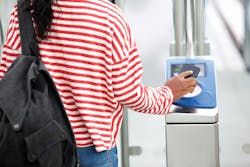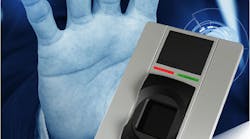Security officials at higher ed institutions perform a delicate balancing act, keeping campuses secure while attempting to preserve freedom of movement for students and faculty. The risk of active shooters is on everyone's mind, as is a heightened awareness of personal safety, cyber threats and identity theft. Students and their parents want to see visible physical and network security measures in place. At the same time, they don't want the campus life experience diminished by inefficient and inconvenient identity management solutions.
Within the past decade, campuses have begun replacing or supplementing student ID cards with mobile credentials. Apple and Android phones now make it easy for students on participating campuses to use their digital wallets to store their student IDs. They can use their phone or watch to interact with access control readers, point-of-sale devices, online test-taking software, and in other scenarios requiring identity verification. In 2021, the University of Alabama became the first school to issue mobile IDs exclusively.
This trend is no surprise. Today's students are digital natives. They carry their phones everywhere and expect to use them for everything. They use Apple Pay and Venmo instead of credit cards. They prefer using digital tickets when attending concerts and sporting events or riding public transportation. They use apps to control the smart home technology they encouraged their parents to install. Why should school be any different? Plus, eliminating plastic cards is consistent with Gen Z's commitment to sustainability. Within the U.S., tens of millions of students are enrolled in higher ed. Imagine how many IDs end up in landfills each year.
However, despite all the benefits of mobile IDs, there are situations on campus when students must or would like to be separated from their devices, at least temporarily. For example, instructors may prohibit the presence of cell phones during exams. Students may find them inconvenient when engaging in certain athletic activities. Some coaches are banning the use of phones during games or practices because social media posts disrupt players' concentration and affect their morale. Students sometimes want to "unplug" for a few hours for mental health reasons. And what if a phone needs charging? A dead phone can't open a door or pay for lunch. Neither can a lost phone. A 100% reliance on mobile credentials is unrealistic.
Enter Biometrics
Colleges and universities have begun integrating biometrics with their campus credentialing platforms, adding a convenient, highly secure, and flexible means to verify and authenticate student identities. Depending on the application and specific setting, biometric identity technology can be deployed in different ways:
• As a choice for students to use instead of presenting a card or phone. Some manufacturers offer solutions that support all three options – biometric, mobile, and RFID – in a single-reader device.
• In conjunction with other modalities – like face and card – for high-security, multimodal authentication.
• In place of a card or mobile reader, for streamlined throughput in high-traffic locations or where other options are impractical. A glance at an iris reader can eliminate the need to carry anything.
College-age students overwhelmingly embrace the speed and convenience of biometric identity verification and authentication. 75% of 18-to-34-year-olds use biometrics with at least one app daily. Allowing them to use biometrics on campus instead of cards or phones meets them in their comfort zone.
Security Applications
Of course, no solution is right in all conditions. It's necessary to consider where and how students will interact with the technology. Biometrics are unlikely to replace cards or phones across entire campuses, but they are ideal for some locations.
Adding biometric readers to exterior doors of residence halls, fraternities, and sororities ensure students never get locked out and prevents credentials from being shared with others. For example, Phi Sigma Kappa at Purdue University and Sigma Phi Epsilon at Kansas State University each use fingerprint biometrics to secure their frat houses. Only residents can enter unescorted.
Alabama's Auburn University has relied on an iris-based biometric identity solution for over a decade within its athletic facilities. The solution is deployed to secure locker rooms and training areas, allowing student-athletes to move about freely while wearing pocketless uniforms, swimsuits, or workout gear.
Rob Stanford, Facilities Management Technology Specialist at Auburn, explains, "When students leave a team or graduate, we just change the permissions and turn off their access. We've had some coaches and students leave and return a few years later. We haven't had to re-enroll them. The system still recognizes them because their eyes don't change. We just reactivate their permissions." The solution can hold and differentiate between thousands of enrollees, including students on the teams, student trainers and managers, coaches, and others with job functions requiring access to regulated areas.
High-security areas like research facilities, labs, and data centers are prime locations for adding biometrics. Universities experienced a 44% increase in cyberattacks in 2022 compared to 2021. 99.9% of modern, automated cyberattacks can be blocked through multifactor authentication (MFI). Many security experts insist that biometrics are the most accurate and reliable form of authentication, making them ideal for MFI in physical and logical security applications. The University of Illinois and the University of Wisconsin use iris-based biometrics in conjunction with their lab facilities' access control systems.
Beyond Security
Biometric identity solutions are ideal for many non-security applications too. Stadiums, theaters, and cafeterias can offer "fast track" lines at entrances and cash registers. Healthcare clinics can immediately identify patients when they check in for appointments, reducing sign-in paperwork and ensuring accurate record-keeping.
They are also an excellent tool to thwart cheating on exams. The frequency of online cheating has increased 14-fold compared to the 15 months before the pandemic. Confirmed incidents include students attempting to take tests on behalf of classmates during proctored exams.
India's Department of Higher Education has mandated that colleges and universities deploy biometric identity solutions to track student attendance and test-taking more accurately. Classroom biometric readers log the identity of students as they enter, preventing an imposter from taking a student's place. American universities may soon embrace similar practices.
Ease of Deployment
Many of today's biometric identity solutions integrate seamlessly with other security, operations, and Point-of-Sale (PoS) platforms thanks to APIs allowing disparate systems to communicate. Campuses can preserve the value of existing technology while adding biometric readers to improve convenience. Students’ biometric data is stored within a siloed, secure, encrypted database that links with the institution’s primary identification platform. Should a network be compromised, there's no risk that a biometric can be reverse-engineered or traced to a student's identity.
Enrolling students is a simple process that any administrator can manage without special technical skills. Some biometric identity solutions even accommodate self-enrollment using the camera on a mobile device.
Biometric solutions may be scaled up over time. Many higher-ed institutions are testing the waters, initially adding biometric readers only at locations with the most urgent requirements to improve safety or convenience. The positive response from students, parents, and faculty paves the way for more widespread adoption.
Today's students crave convenience, speed, and simplicity. At the same time, campuses are struggling with expanding operational requirements, shrinking enrollments, greater competition, and tighter budgets. In response, student identity platforms are under scrutiny.
The next few years will prove pivotal as higher-ed institutions transition away from plastic and look for ways to meet Gen Z students in their comfort zone – where convenience and sustainability are both highly valued. Integrating biometrics with campus credentialing platforms will deliver on both while helping colleges and universities remain competitive, improve efficiencies, and increase safety.
This article appeared in the July/August issue of Security Technology Executive.
About the author: Bobby Varma is the CEO/ Founder of Princeton Identity, a manufacturer of biometric identity solutions to streamline security, optimize operations, and control costs. She is a recipient of SIA's 2022 Women in Biometrics Award and a member of SIA Women in Security Forum's Power 100.






